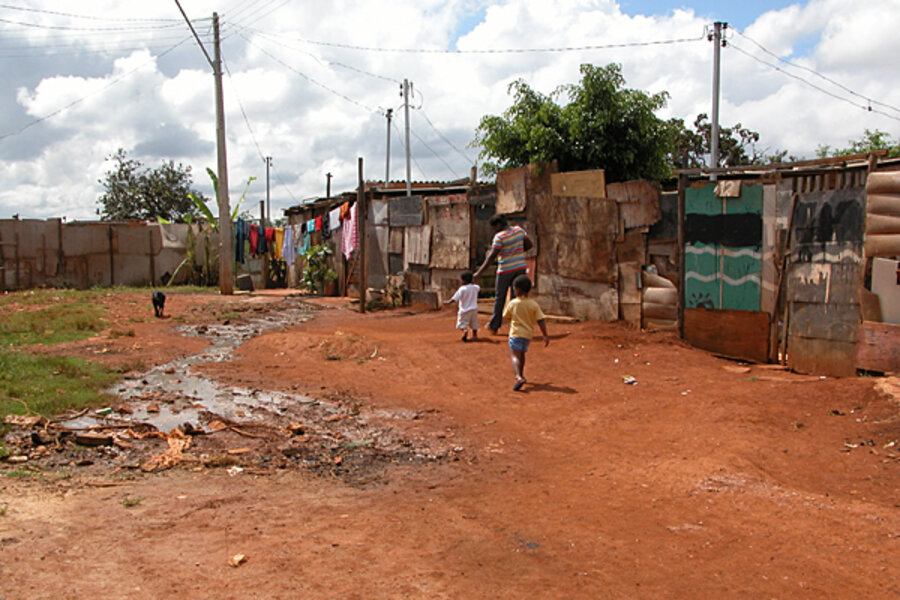Global Hunger Index top 10: Which nations have reduced hunger most?
Loading...
| Washington
To understand how the world has reduced the ranks of the hungry over two decades, take a look at Malaysia.
Food and nutrition programs targeting the very youngest have been added to sustained economic growth, and that combination has put the Southeast Asian country near the top of the list of the world’s hunger reducers.
To zero in on why hunger remains a global challenge and an economic stumbling block in many countries – principally in sub-Saharan Africa – look no further than the Democratic Republic of the Congo.
There, a nefarious combination of conflict and deteriorating government services and infrastructure have led to a 66 percent rise in the ranks of the hungry over two decades. Three-quarters of the population now suffers from hunger.
The Global Hunger Index released Monday finds that many developing countries primarily in South Asia and Latin America have made significant progress in reducing hunger. But continued improvement in the rates of hunger – and in addressing the development problems that result from hunger – depends on a universal focus on early childhood nutrition.
“Child nutrition is one of the biggest challenges to reducing global hunger,” says Marie Ruel, director of the poverty, health, and nutrition division at the International Food Policy Research Institute (IFPRI) in Washington.
The 1,000 days of life “from conception to two years” go a long way in setting a child’s health, education, and productivity patterns, she says, adding: “In order to improve the hunger index, countries will have to accelerate progress in child nutrition.”
World Food Day coming
The Global Hunger Index, or GHI, is a country-by-country report card issued to correspond with World Food Day on Oct. 16. Two international poverty- and hunger-reduction nongovernmental organizations, Germany’s Welthungerhilfe and Ireland’s Concern Worldwide, team up with IFPRI to deliver the annual snapshot of global hunger.
The report comes as the world makes some progress in reducing the spike in global hunger that followed an onslaught of food shortages and food price hikes in 2008, food experts say. But they add that the world remains far from achieving the goal, set by world leaders in 2000, of cutting world hunger in half by 2015.
“The number of hungry people has actually been increasing … on the heels of a global food price crisis and in the midst of worldwide recession,” says the foreword to the report. The good news, it adds, is that the number of undernourished people globally is estimated to have fallen from the spike of more than 1 billion in 2009 to 925 million this year.
Global hunger has fallen by about a quarter since 1990, Ms. Ruel notes. And some food experts say they are seeing the focus on early childhood nutrition that is necessary to sustain that progress.
“We are serious political momentum building behind this issue,” says Tom Arnold, chief executive of Concern Worldwide, noting a "road map" for scaling up nutrition at a UN summit last month.
Some highlights from the 2010 Global Hunger Index:
The Top 10 hunger reducers since 1990 (from No. 10 to No. 1)
- Peru
- Saudi Arabia
- Iran
- Ghana
- Nicaragua
- Tunisia
- Mexico
- Turkey
- Malaysia
- Kuwait
The Top 9 where hunger increased (from less to most)
- The Gambia
- Liberia
- Guinea Bissau
- Zimbabwe
- Swaziland
- North Korea
- Burundi
- Comoros
- Democratic Republic of the Congo
The best
Malaysia has built on a history of hunger-reduction programs to focus more recently on child nutrition and in particular on addressing a prevalence of underweight children. Malaysia has increased food aid for families with malnourished children, while coupling the aid with nutrition education programs. Also up: supplementary feeding programs for preschool and primary school children.
The worst
It would be hard to find a more perfect storm for hunger than in the Democratic Republic of the Congo, where a long civil war, massive population displacement, and a general economic decline have led to widespread food insecurity – and rising hunger and chronic malnutrition. As food production has collapsed, emergency food assistance has increased to keep much of the population alive – but does little, food experts say, to address long-term issues like childhood malnourishment and self-sustainability.
The lagger
Despite impressive economic growth rate in recent years, India stands out for its poor performance in reducing its overall hunger rate and in particular child malnutrition. (As opposed to China, which has combined high economic growth with focused government programs to deliver an impressive reduction in rates of hunger). More than 40 percent of children under 5 in India are underweight – a result, some food experts say, of the low nutritional and social status of women in the country.
The example
Brazil is one Latin American country that has used what is called a “conditional cash transfer” program to accelerate what had been gradual progress in reducing hunger and childhood malnutrition. Called “Bolsa Familia,” the program puts cash in the hands of poor Brazilian families that commit to putting children in school and keeping them there.
In Brazil, the program has helped to reduce the number of stunted children and to raise the nutrition levels of impoverished children closer to those of their wealthier cohorts.
“We’re learning a lot of lessons from Latin America,” says IFPRI’s Ruel, who notes that Brazil’s program works – much like a similar one in Mexico – because it is tied to community-level nutrition education programs.
Testing the cash transfer format, Concern Worldwide has established a $25 million program in Niger that sends cash to mothers through their cell phones to allow them to buy foods in local markets.





